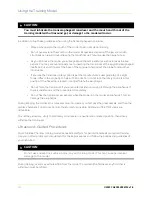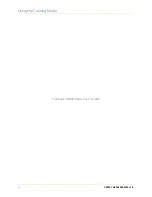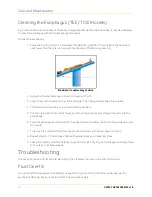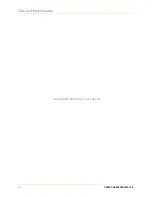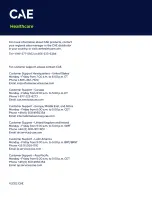
Using the Training Model
8
©2022 CAE 905K004752 v1.0
To simulate blood in the pericardial fluid, add a small amount of red fluid to the clear fluid before filling the
pericardial space.
The FAST models have three additional tubes for dynamically adjustable organ effusion spaces:
• one to fill and adjust fluid levels in the liver
• one to fill and adjust fluid levels in the spleen
• one to fill and adjust fluid levels in the bladder
To fill fluid spaces, use one of these methods:
Method A: Syringe Fill (also to remove air)
1. Stand the model upright.
2. Remove the cap of the fill tube.
3. Fill a syringe half-full and connect it to the tube.
4. Hold the tube up and tap it to move any air bubbles upwards.
5. Aspirate the air before before filling for optimal imaging.
6. Inject 10 ml of fluid.
7. Remove 5 ml of fluid along with any air.
8. Repeat steps 4 through 7 until all the air is removed.
9. Continue filling according to the table. Do not exceed the maximum fluid volumes or damage to
your model may occur.
10. Remove the syringe and replace the cap.
Method B: Quick-Fill port for high volume use
1. Connect an IV bag containing CAE Blue Phantom fluid to the fill tube.
2. Hang the IV bag no more than 12 inches (30 cm) above the training model to avoid overfilling.
NOTE: A clear sign of overfill is the appearance of small dimples of simulated blood on the
surface of the model at the sites of previous cannulations. To correct overfill, see the
Troubleshooting
section.
Effusion Size
Heart
Liver
Spleen
Bladder
Small
50 ml
100 ml
50 ml
25 ml
Medium
100 ml
150 ml
100 ml
50 ml
Large
150 ml
225 ml
150 ml
75 ml
MAXIMUM FILL
500 ml
1000 ml
700 ml
300 ml
Summary of Contents for Blue Phantom Echocardiography and Pericardiocentesis Ultrasound Training Model
Page 1: ......
Page 2: ......
Page 4: ...Contents ii 2022 CAE 905K004752 v1 0 THIS PAGE INTENTIONALLY LEFT BLANK...
Page 10: ...Introduction 6 2022 CAE 905K004752 v1 0 THIS PAGE INTENTIONALLY LEFT BLANK...
Page 16: ...Using the Training Model 12 2022 CAE 905K004752 v1 0 THIS PAGE INTENTIONALLY LEFT BLANK...
Page 20: ...Care and Maintenance 16 2022 CAE 905K004752 v1 0 THIS PAGE INTENTIONALLY LEFT BLANK...
Page 21: ......














